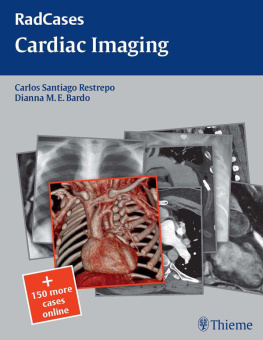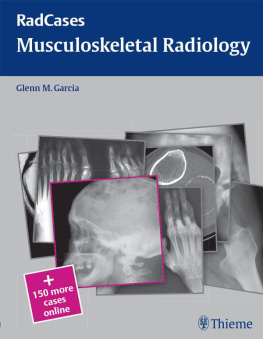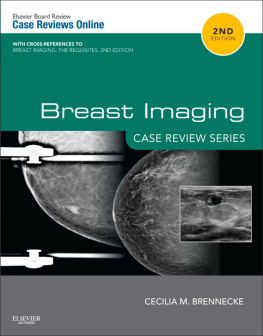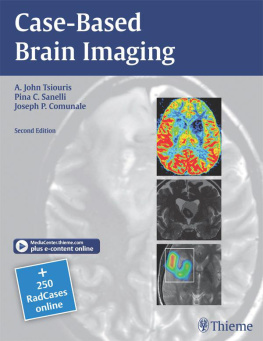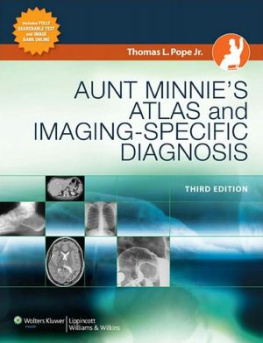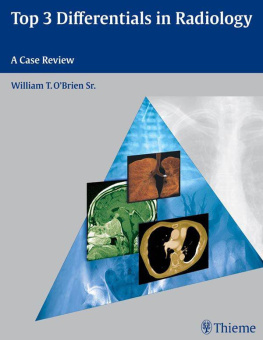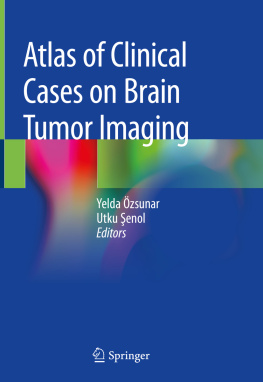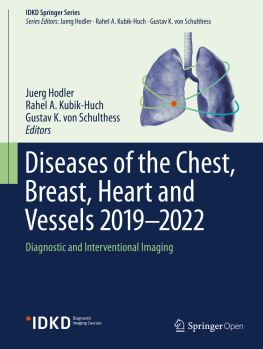Chest Imaging Case Atlas
Second Edition
Mark S. Parker, MD
Professor, Diagnostic Radiology and Internal Medicine
Department of Radiology
VCU Medical Center
Richmond, Virginia
Melissa L. Rosado-de-Christenson, MD, FACR
Section Chief
Department of Thoracic Imaging
Saint Lukes Hospital of Kansas City
Professor of Radiology
University of MissouriKansas City
Kansas City, Missouri
Gerald F. Abbott, MD
Associate Professor of Radiology
Harvard University
Associate Radiologist
Massachusetts General Hospital
Boston, Massachusetts
Thieme
New York Stuttgart
Thieme Medical Publishers, Inc.
333 Seventh Ave.
New York, NY 10001
Executive Editor: Timothy Hiscock
Managing Editor: J. Owen Zurhellen IV
Editorial Assistant: Michael Rowley
Production Editor: Kenneth L. Chumbley
International Production Director: Andreas Schabert
Senior Vice President, International Marketing and Sales: Cornelia Schulze
Vice President, Finance and Accounts: Sarah Vanderbilt
President: Brian D. Scanlan
Compositor: Prairie Papers Inc.
Printer: Sheridan Books, Inc.
Library of Congress Cataloging-in-Publication Data
Parker, Mark S.
Chest imaging case atlas/Mark S. Parker, Melissa L. Rosado-de-Christenson, Gerald F. Abbott. 2nd ed.
p.; cm.
Rev. ed. of: Teaching atlas of chest imaging. c2006.
Includes bibliographical references and index.
ISBN 978-1-60406-590-9 (alk. paper)
I. Rosado de Christenson, Melissa L. II. Abbott, Gerald F. III. Parker, Mark S. Teaching atlas of chest imaging.
IV. Title.
[DNLM: 1. Diagnostic ImagingAtlases. 2. Diagnostic ImagingCase Reports. 3. Thoracic DiseasesdiagnosisAtlases. 4. Thoracic DiseasesdiagnosisCase Reports. 5. Radiography, ThoracicAtlases.
6. Radiography, ThoracicCase Reports. WF 17]
617.5407572dc23
2011052038
Copyright 2012 by Thieme Medical Publishers, Inc. This book, including all parts thereof, is legally protected by copyright. Any use, exploitation, or commercialization outside the narrow limits set by copyright legislation without the publishers consent is illegal and liable to prosecution. This applies in particular to photostat reproduction, copying, mimeographing or duplication of any kind, translating, preparation of microfilms, and electronic data processing and storage.
Important note: Medical knowledge is ever-changing. As new research and clinical experience broaden our knowledge, changes in treatment and drug therapy may be required. The authors and editors of the material herein have consulted sources believed to be reliable in their efforts to provide information that is complete and in accord with the standards accepted at the time of publication. However, in view of the possibility of human error by the authors, editors, or publisher of the work herein or changes in medical knowledge, neither the authors, editors, nor publisher, nor any other party who has been involved in the preparation of this work, warrants that the information contained herein is in every respect accurate or complete, and they are not responsible for any errors or omissions or for the results obtained from use of such information. Readers are encouraged to confirm the information contained herein with other sources. For example, readers are advised to check the product information sheet included in the package of each drug they plan to administer to be certain that the information contained in this publication is accurate and that changes have not been made in the recommended dose or in the contraindications for administration. This recommendation is of particular importance in connection with new or infrequently used drugs.
Some of the product names, patents, and registered designs referred to in this book are in fact registered trademarks or proprietary names even though specific reference to this fact is not always made in the text. Therefore, the appearance of a name without designation as proprietary is not to be construed as a representation by the publisher that it is in the public domain.
Printed in the United States of America
5 4 3 2 1
ISBN 978-1-60406-590-9
eISBN 978-1-60406-591-6
To my heavenly Father, for the innumerable blessings He has afforded me in life. To my grandparents, for their love and encouragement from the beginning of my journey. To my parents, for the opportunities they provided and encouragement they offered. To my wife Cindy, for whom nothing in my personal or professional life would be possible without her unwavering love, support, and patience. To my son, Steven, and my daughter, Casey, for their love, support, and countless sacrificed hours of family time. To my colleagues and friends, Melissa and Gerry, for their friendship, dedication, and conscientious work on this project.
Mark S. Parker, MD
To my husband, Paul J. Christenson, MD, my daughters, Jennifer and Heather, for their love, support, and encouragement. And to the countless radiology residents it has been my privilege to teach over the course of my career and to my colleagues at the Saint Lukes Hospital of Kansas City, Missouri, whose curiosity, enthusiasm, and thirst for knowledge greatly enrich my academic life.
Melissa L. Rosado-de-Christenson, MD, FACR
To the many radiology residents I have had the pleasure and honor of teaching at Massachusetts General Hospital, Rhode Island Hospital, and the Armed Forces Institute of Pathology. Your spirit and enthusiasm make it all enjoyable.
Gerald F. Abbott, MD
CONTENTS
SECTION I
Normal Thoracic Anatomy
SECTION II
Developmental Anomalies
SECTION III
Airways Disease
SECTION IV
Atelectasis
Patterns of Lobar Atelectasis
Patterns of Multi-Lobar Atelectasis
Miscellaneous Patterns of Atelectasis
SECTION V
Pulmonary Infections and Aspiration Pneumonia
Less Common Bacterial Pneumonias
Miscellaneous
SECTION VI
Neoplastic Disease
SECTION VII
Thoracic Trauma
Non-Vascular Thoracic Trauma Pleura Injuries
Parenchymal Lung Injuries
Airways Injuries
Pericardial and Cardiac Injuries
Diaphragmatic Injuries
Thoracic Skeletal and Chest Wall Injuries
Vascular Thoracic Trauma
Miscellaneous
SECTION VIII
Diffuse Lung Disease
SECTION IX
Occupational Lung Disease
SECTION X
Adult Cardiovascular Disease
Pulmonary Artery
Pulmonary Edema
Abnormalities of the Thoracic Aorta
Valvular Disease
Myocardial Calcifications
Pericardial Disease
Vasculitides
Cardiac Masses
Miscellaneous
Cardiac Devices
SECTION XI
Abnormalities of the Mediastinum
SECTION XII
Pleura, Chest Wall, and Diaphragm
SECTION XIII
Post-Thoracotomy Chest
FOREWORD
Cardiothoracic radiology is at the heart of radiology, with no single examination being performed more often in private or academic practice environments than the chest radiograph. A survey of X-ray use in the early 1960s by the National Center for Health Statistics reported that medical radiation accounted for half of human radiation exposure, and that of the 85 million visits for X-rays, 51 million (60%) were for chest X-rays (Health Statistics, US National Health Survey, Volume of X-ray Visits, U.S. Department of Health, Education and Welfare, October 1962). Today, estimates are that over 100 million chest X-rays are performed annually in the United States. While seemingly simple and straightforward, it can be argued that there is no exam more complex and nuanced in the entire field of radiology. I remember attending an American College of Radiology Intersociety Conference in 1998 on the topic of Are todays residents ready for tomorrows practice?, the summary of which concluded that residents not only needed to be prepared to read large numbers of films accurately and efficiently, but that they be able to recognize normal, with all of its variations, in order to minimize recommendations for more complex and expensive testing, only to discover there was nothing of clinical significance.
Next page



